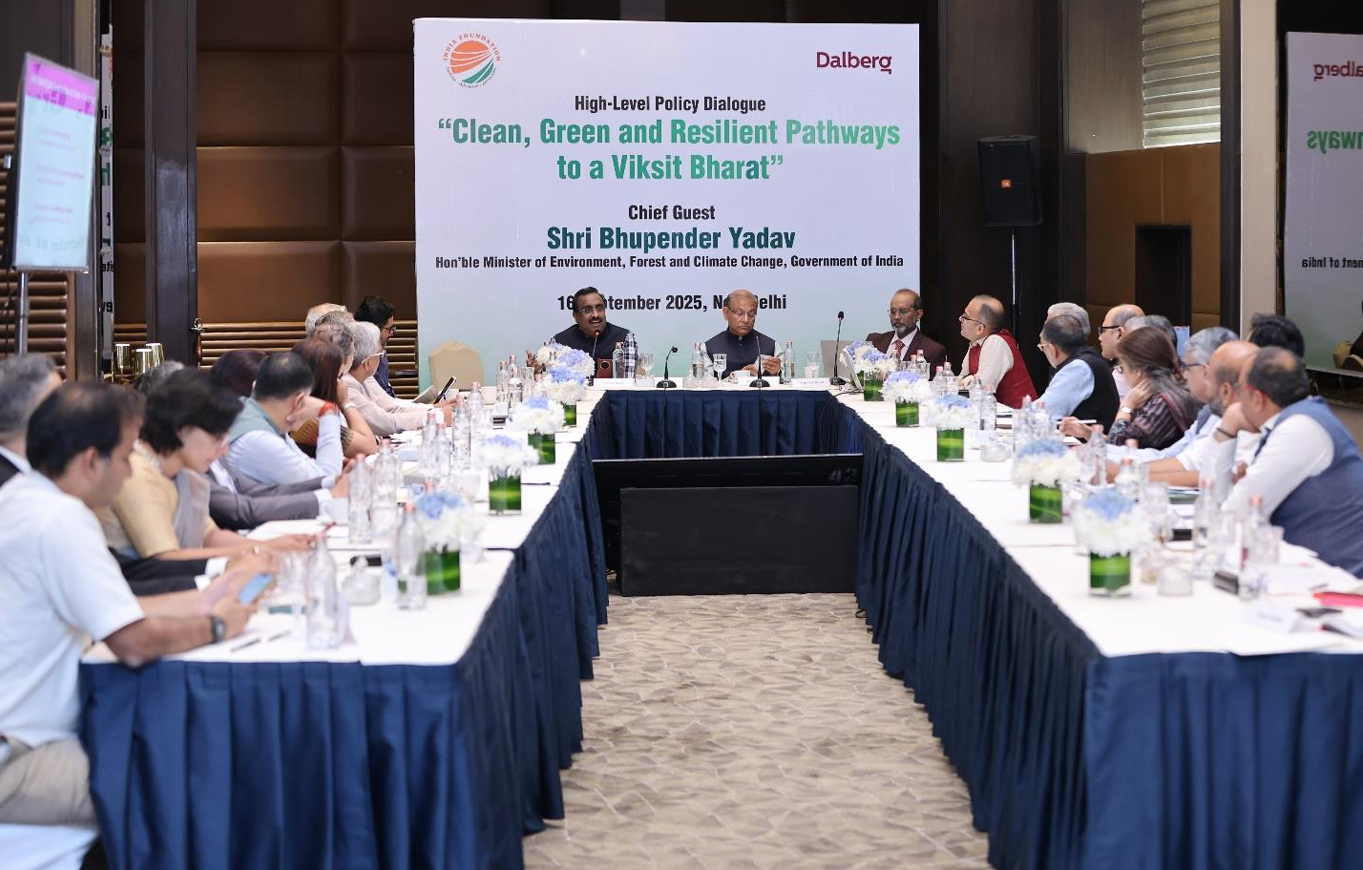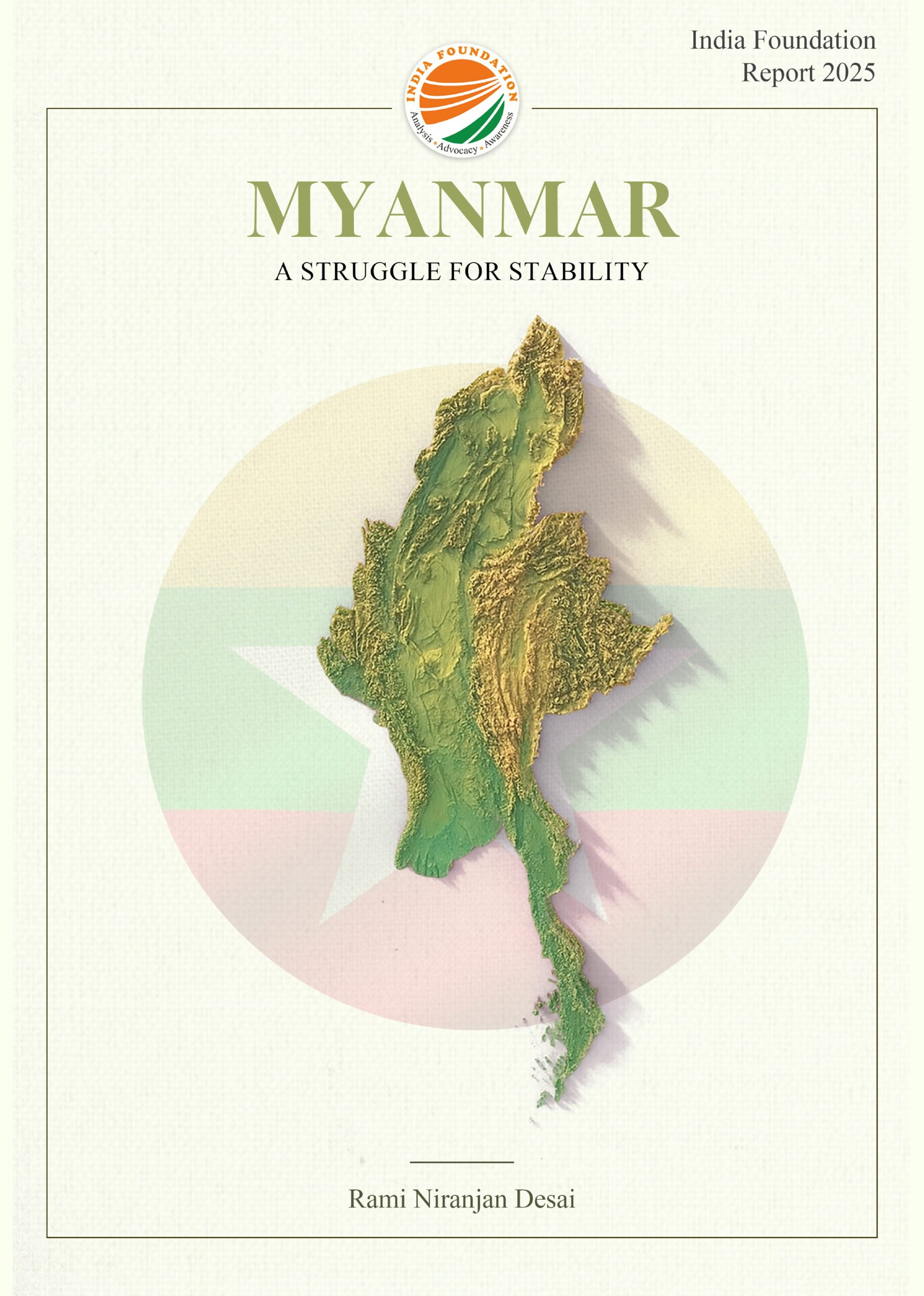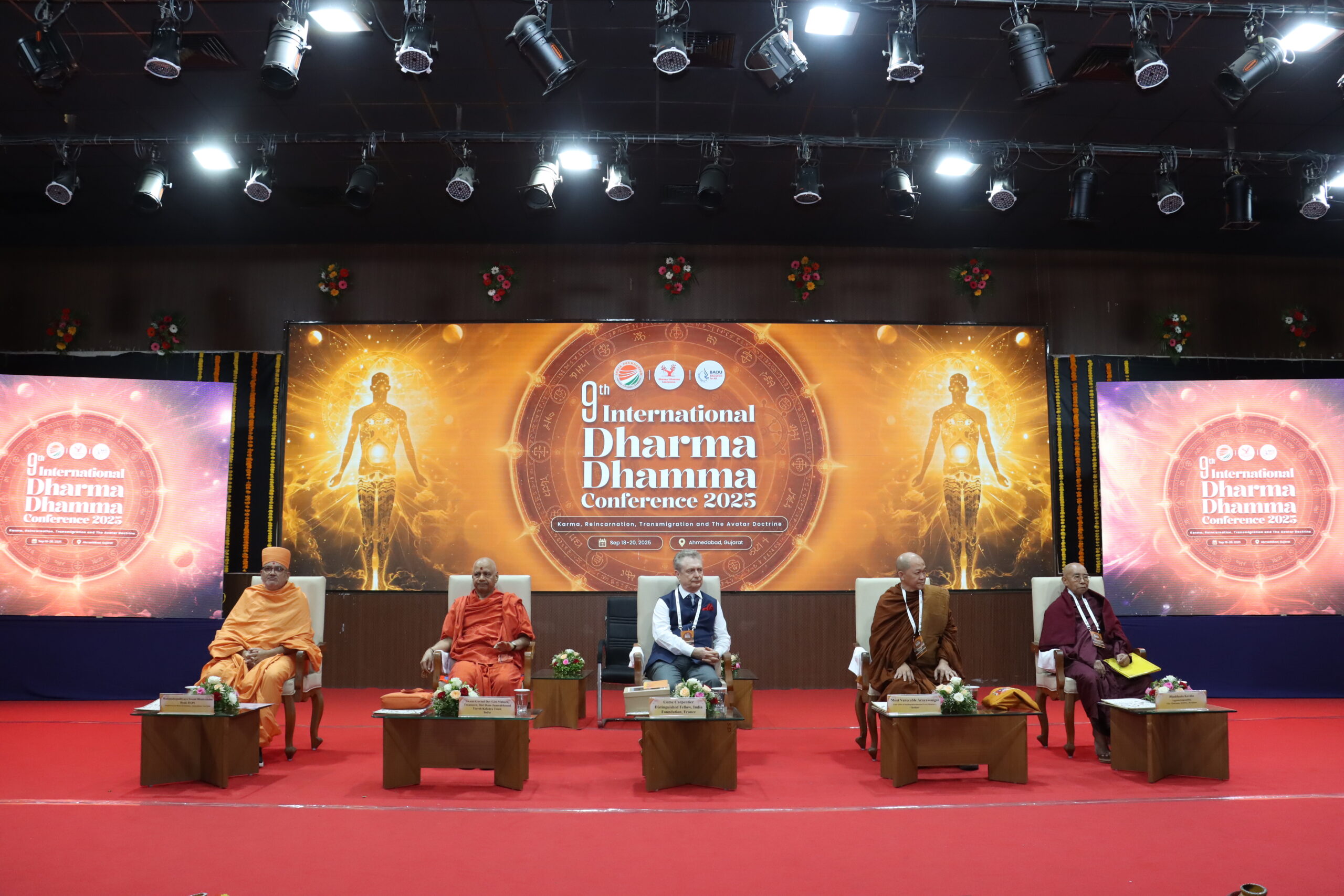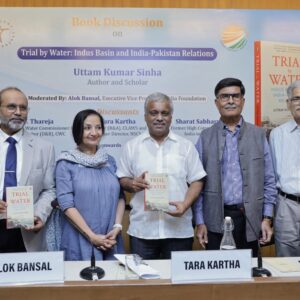1. Introduction
On 16 September 2025, the India Foundation and Dalberg Advisors jointly convened a High-Level
Policy Dialogue in New Delhi to deliberate on strategic approaches to realizing the vision of Viksit
Bharat @ 2047 – a developed, inclusive, sustainable, and resilient India. This gathering brought
together senior policymakers, business leaders, civil society representatives, academics, and
international experts. The dialogue focused on aligning India’s economic aspirations with a robust
climate strategy, making the case that climate action is not merely an environmental imperative
but a central pillar of national growth and competitiveness.
Participants agreed that integrating climate considerations into India’s development framework is
essential to safeguard productivity, ensure resilience, and maintain global leadership. As India sets
its sights on becoming a $30 trillion economy by 2047, the dialogue underscored the need to
embed sustainability into every level of economic and social planning.
2. Strategic Themes and Insights
2.1 Climate Resilience as Economic Strategy
Climate resilience was recognised as a foundational requirement for sustained economic output.
Projections indicate that without timely adaptation, India could face economic losses exceeding
$1.5 trillion by 2050, particularly in high-risk sectors such as agriculture, MSMEs, and urban
infrastructure. Given that over 85% of India’s districts are climate-vulnerable, the dialogue called
for urgent investments in resilient urban planning, adaptive agriculture, and protective
infrastructure.
Building resilience now will not only mitigate future disaster-related costs but also preserve
productivity and enhance social equity. Policy mechanisms that support climate-proofed
infrastructure and climate-smart agriculture were identified as immediate priorities.
2.2 Energy Transition and Green Electrification
India’s energy demand is expected to rise sharply, reaching 708 GW by 2047. To meet this need
while decarbonising the economy, the transition to clean electricity, green hydrogen, and bioenergy
must accelerate. The National Electricity Plan projects that 90% of India’s power should come from
non-fossil fuel sources by 2047.
The dialogue introduced the concept of “Electricity as the next UPI” – a digitally integrated, low
cost power grid that uses AI, IoT, and blockchain to reduce system losses and improve efficiency.
Participants stressed the need for robust policy and investment to support the development of this
infrastructure, while ensuring energy access remains equitable.
2.3 Green Trade and Supply Chain Resilience
India’s ability to compete in the global marketplace increasingly depends on carbon
competitiveness. With 68% of Indian exports destined for net-zero economies, failure to
decarbonise industrial production could result in restricted market access and loss of export
revenue.
Climate-induced disruptions such as floods and heatwaves already threaten manufacturing hubs
and logistics networks. The dialogue stressed the importance of investing in low-carbon
manufacturing, resilient infrastructure, and clean logistics. Strategic upgrades to export-oriented
industrial clusters were highlighted as vital for maintaining India’s trade leadership.
2.4 Financing the Green Transition
To meet its net-zero and climate resilience goals, India requires an estimated $150–170 billion in
annual green investment. The operationalisation of a national climate finance taxonomy was
identified as a critical enabler. This framework would provide clarity to investors, reduce
greenwashing, and support the flow of public and private capital.
Participants called for the expansion of blended finance models and de-risking mechanisms to
unlock private investment, especially in sectors with long payback periods. The importance of
developing a pipeline of bankable projects was also emphasised to catalyse institutional financing.
2.5 Global Leadership Through Climate Diplomacy
India’s growing influence in the global south presents an opportunity to shape international climate
agendas. Initiatives such as the International Big Cat Alliance, International Solar Alliance, and
Global Biofuels Alliance serve as platforms to demonstrate leadership in biodiversity conservation
and clean technology.
The dialogue encouraged the government to leverage these platforms, along with global forums
such as COP33, to promote India’s green development model and deepen South-South
cooperation on technology, finance, and climate resilience.
3. Sectoral and Governance Priorities
India’s conservation strategy must aim to expand protected areas to 10% of total land and maintain
at least 30% forest cover by 2047. This will require scaling flagship initiatives like Project Tiger, the
Cheetah Reintroduction Program, and the International Big Cat Alliance. These efforts should be
integrated with development planning and backed by strong governance and enforcement
mechanisms.
The MSME sector, comprising over 63 million enterprises, plays a pivotal role in employment and
exports but remains highly vulnerable to climate impacts. Support mechanisms such as green
financing, cluster-based innovation hubs, and digital transformation tools are essential to enable a
just transition.
Technology and innovation must drive India’s climate and development agenda. Key investment
areas include hydrogen R&D, AI-enabled climate analytics, circular economy solutions, and low
emission agricultural practices. Research institutions and private enterprises require targeted
policy and funding support to accelerate technology deployment.
Subnational governments are central to climate implementation. Empowering states and districts
through mandatory climate risk assessments, adaptation planning, and financial devolution will be
essential. Cooperative federalism must guide this approach, particularly in vulnerable regions like
Bihar, Odisha, and the Indo-Gangetic belt.
Lastly, inclusive development must remain the cornerstone of India’s climate strategy. Engaging
youth through platforms such as Viksit Bharat @ 2047: Voice of Youth, expanding sustainable
housing, and integrating climate considerations into public health are key to building community
resilience.
4. Policy Recommendations
To translate these deliberations into actionable reforms, the dialogue outlined seven core policy
directions.
First, climate priorities must be embedded across all levels of economic policymaking. From fiscal
frameworks and industrial policy to infrastructure design, climate considerations must guide
investment decisions and resource allocation.
Second, India must rapidly scale up green finance. This includes full operationalisation of the
climate finance taxonomy, development of de-risking instruments, and enhanced coordination
between public agencies and private investors to mobilise the necessary $150–170 billion
annually.
Third, conservation goals must be scaled significantly. Expanding protected areas, restoring
degraded ecosystems, and achieving zero poaching of Schedule-I species should be embedded in
India’s development and land-use frameworks.
Fourth, cleantech innovation must be fast-tracked. Government and private sector R&D
investment should prioritise hydrogen, biofuels, AI-powered energy solutions, and sustainable
agriculture technologies. National institutions must be empowered to lead this innovation drive.
Fifth, subnational governance must be strengthened. States and municipalities need technical and
financial support to conduct climate risk assessments and implement adaptation strategies.
Cooperative federalism will be key to ensuring that climate goals are met across diverse
geographies.
Sixth, MSMEs must be enabled to adopt green practices. Dedicated green financing lines, capacity
building programs, and digital infrastructure are needed to help small enterprises stay competitive
and resilient.
Seventh, inclusivity must anchor all efforts. Policies must prioritise youth engagement, promote
affordable green housing, and integrate climate-health linkages into public systems. Community
led conservation and adaptation models should be scaled to ensure local ownership and impact.
5. Conclusion
The High-Level Dialogue reaffirmed that India’s path to becoming a developed economy by 2047
must be clean, green, and resilient. Climate action is not a constraint on growth; it is the most
strategic enabler of sustainable prosperity and global competitiveness.
India has the opportunity—and the imperative—to lead the global green transition. The insights and
recommendations generated through this dialogue offer a roadmap to accelerate climate-smart
development. India Foundation and Dalberg Advisors remain committed to supporting the Ministry
of Environment, Forest and Climate Change in translating these priorities into policy, partnerships,
and implementation frameworks for a climate-resilient Viksit Bharat.
Chair: Dr. Ram Madhav, President, India Foundation
Special Addressee: Mr. Jayant Sinha, Former Minister of State, Government of India
Invitees for the High-Level Strategic Interventions
1. Ms. Akshima Tejas Ghate, Managing Director, Rocky Mountain Institute India
2. Dr. Alok Sikka, Country Representative – India, International Water Management Institute
3. Dr. Amit Kapoor, Chair, Institute for Competitiveness
4. Mr. Amit Prothi, Director General, Coalition for Disaster Resilient Infrastructure
5. Ms. Archna Vyas, Global Director of Policy and Communications, Gates Foundation
6. Ms. Cecilia Tall, Counsellor for Science and Technology, Embassy of Sweden
7. Ms. Charu Chadha, Consultant – Asia Regional Office, The Rockefeller Foundation
8. Mr. Deo Datt Singh, Director, People’s Action for National Integration
9. Mr. Jatinder Cheema, Principal, JC Law Advocates and Solicitors
10. Mr. Kamlesh Kumar Mishra, Joint Secretary, 16th Finance Commission, Government of India
11. Mr. Koyel Kumar Mandal, Director, Climate – India, Children’s Investment Fund Foundation
12. Ms. Mahua Acharya, Founder and CEO, International Energy Transition Platform
13. Dr. Manoj Singh, Additional Member, Railway Board, Government of India
14. Mr. Mudit Narain, Energy Advisor, Social Alpha
15. Mr. Nabin Kumar Roy, General Manager, National Bank for Agriculture and Rural Development
16. Mr. Pawan Mulukutla, Executive Programme Director, World Resources Institute India
17. Mr. Randheer Singh, Founder and Chief Executive Officer, ForeSee Advisors
18. Dr. Ravindra Kumar Singh, CGM, Small Industries Development Bank of India
19. Dr. Satya Prakash Yadav, Director General, International Big Cat Alliance
20. Ms. Seema Paul, Programme Director, Sequoia Climate Foundation
21. Dr. Sharath Rao, Fellow, Centre for Social and Economic Progress
22. Mr. Shombi Sharp, United Nations Resident Coordinator in India
23. Mr. Vaibhav Pratap Singh, Executive Director, Climate and Sustainability Initiative
24. Mr. Vivek Sen, India Director, Climate Policy Initiative
Curators
1. Mr. Jagjeet Singh Sareen, India Head, Dalberg Advisors
2. Mr. Shashvat Singh, Senior Research Fellow, India Foundation




